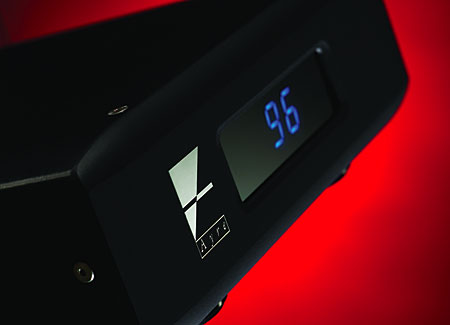| Columns Retired Columns & Blogs |
I was looking for copyright and/or patent info on "Streamlength" and found none (only a TM).
Please reply with more info on this issue as necessary. Thx!
I might get burned up by the sun
The obvious question, I reckon, is that if using a computer as a source component for music isn't brain-dead easy, why bother? Well, spinning LPs isn't brain-dead easy either—people put up with the aggravation because they like the sound. Now, for the first time ever, audiophiles can own recordings in their native resolutions, and the places where we can download music in resolutions and sample rates higher than the Compact Disc's "Red Book" standard are proliferating. I want those higher resolutions, and I want 'em now.

I've downloaded files from Linn, Naim, and HDtracks that sound better than any CD I own—and Gordon Rankin, God love 'im, sent me an external Western Digital Passport 320GB hard drive packed with hi-rez offerings to use for this review. John Atkinson had added the 24-bit, 88.2kHz master files for his recent Cantus, Robert Silverman, and Attention Screen recordings, but also on the drive was a 24-bit/44.1kHz version of Rhapsody, John Atkinson's recording of pianist Hyperion Knight playing the music of Gershwin (CD, Stereophile STPH010-2)—a significant recording in my digital education. JA had recorded those 1997 sessions at 24 bits, but the CD master, of course, had to be dithered down to 16 bits. Now, hearing those recordings at their 24-bit resolution through the Ayre QB-9 was wonderful. The difference made by those extra eight bits wasn't tonal or timbral—what had changed was the presence of the music: 24 bits put me there—16 bits simply didn't.
Also on Rankin's hard drive was a 24/96 version of the title track of Olu Dara's Neighborhoods (CD, Atlantic 83391-2). It sets up a lazy groove that just ambles along, and through the QB-9 it popped with life—the congas had more snap, and the shimmering overtones of Dara's guitar lingered longer in the air. Most of all, that slow groove was more solid—analog lovers like to extol the "flow" of their preferred format, and hi-rez digital seems to do much the same thing. I've listened to the CD of Neighborhoods many times since its release in 2001, so I wasn't reacting to the novelty of the music; instead, I was marveling at how good this old friend sounded at 24/96.
Rankin also included 24/96 files of John Gorka's The Gypsy Life (DVD-Audio, AIX 83053). I'm a big fan of AIX's hi-rez releases, and of Gorka, so I cued "I Saw a Stranger with Your Hair." Wowsers. Lots of big room acoustic and big, big bass sound from Michael Manring, but what floored me was the realism of Gorka's voice, especially his harmonies with Susan Werner and Amelia Spicer. Those people were in my room—and my room had gotten so big!
Then I discovered that Rankin's magic box also included David Crosby's If I Could Only Remember My Name... (Atlantic SD-7203) as 24/96 files. I had to hear "Cowboy Movie." Holy cow—even when downsampled to 96kGHz by iTunes' QuickTime engine, it had never sounded like that, not even with pharmaceutical enhancements. The sound was huge, and the crackling guitar exchanges between Crosby, Jerry Garcia, and Jorma Kaukonen were practically physical in their impact. And at the end, when everything just grinds to a halt, I could hear a few seconds of studio ambience to an extent I'd never before experienced.
Producer's Cut (DVD-A, Rhino 78174) comprises 24/96 files of 14 of Emmylou Harris's finest recordings. I've been listening to that woman since before she met Gram Parsons—I can't tell you how many times I sat in the Prism coffee house in Charlottesville, Virginia, listening to her within touching distance—so I've got a pretty good handle on what her voice sounds like. Producer's Cut completely nails it—I have never heard "Boulder to Birmingham" sound better. Harris's voice had a truly physical body supporting it, and her silvery topmost register was burnished even brighter than usual. And, oh yes, in 24/96 I had a deeper emotional connection to her music than ever, if such a thing is possible.
Good work, QB-9.
One thing I've almost overlooked is how well the QB-9 performed with non–hi-rez files. Aguston Barrios Mangoré's "Cueca," from guitarist David Russell's The Music of Barrios (CD, Telarc CD-80373), which I'd ripped to my own hard drive as an AIF file, sounded great! Again, I noted an admirable amount of acoustic support for the guitar's tone, especially when Russell rapped on his soundboard while playing a countermelody high on the frets—ha! made me jump! The absence of artificial texture, and my ability to hear deep into the soundstage, made me suspect that the QB-9 indeed does have low levels of noise and jitter.
They say we don't listen anyway
I had on hand the Bel Canto's USB Link 24/96 USB-to-S/PDIF converter ($495) and e.One DAC3 ($2495). The combination, with the USB Link feeding one of the DAC3's S/PDIF inputs, seemed like a natural for comparison with the Ayre QB-9. I understand that Bel Canto has incorporated some improvements in the e.One DAC3, and I'd been scheduled to send in my sample for those upgrades—but I held off, thinking the Ayre deserved a challenge like the Bel Cantos, which had been making me very, very happy.

I was looking for copyright and/or patent info on "Streamlength" and found none (only a TM).
Please reply with more info on this issue as necessary. Thx!